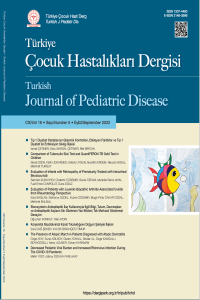Limb Girdle Muscular Dystrophy Type 2a: Case Report
Öz
Limb Girdle Muskular distrofi (LGMD) kalça ve omuz ekleminde progresif kronik güçsüzlük ile seyreden kalıtımsal bir grup kas distrofisidir. Kalıtım paterni otozomal dominant (LGMD1) ve otozomal resesif (LGMD2) olarak ikiye ayrılır. LGMD tip 2A kalpain proteinini kodlayan gen defektine neden olan kalpainopati olarak bilinmektedir. Kas güçsüzlüğü ve başlangıç yaşına göre 3 çeşit kalpainopati tipi vardır. Bu yazıda asemptomatik persistan kreatin kinaz yüksekliği olan, kas biyopsisi ve genetik analiz ile LGMD tip 2A tanısı alan çocuk hasta sunulmaktadır. Genetik analiz sonucunda CAPN3 geninde (c.2092C>A) homozigot mutasyonu mevcut olup ebeveynlerin genetik analizinde heterozigot taşıyıcı olarak saptanmıştır.
Anahtar Kelimeler
Biyopsi Kalpainopati Kas Muskular distrofi Limb girdle muskular distrofi
Kaynakça
- 1. Lash T, Kraemer RR. Elevated Liver Enzymes Indicating a Diagnosis of Limb-Girdle Muscular Dystrophy . J Gen Intern Med 2014 May; 29(5): 813-15.doi: 10.1007/s11606-014-2766-4. Epub 2014 Jan 23
- 2.Khadilkar SV, et al. Making sense of the clinical spectrum of limb girdle muscular dystrophies. Pract Neurol 2018;0:1–10. doi:10.1136/practneurol-2017-001799
- 3. Angelini C, Fanin M. Calpainopathy. In: Adam MP, Ardinger HH, Pagon RA, Wallace SE, Bean LJH, Stephens K, Amemiya A, editors. Gene Reviews. Seattle (WA): University of Washington,Seattle.2005:1993-2018
- 4.Angelini C, Giaretta L, Marozzo R. An update on diagnostic options and considerations in limb girdle dystrophies. Expert Rev Neurother. 2018; Sep;18(9):693-703 DOI: 10.1080/14737175.2018.1508997
- 5.Vainzof M, de Paula F, Tsanaclis AM, Zatz M. The effect of calpain 3 deficiency on the pattern of muscle degeneration in the earliest stages of LGMD2A. J Clin Pathol. 2003;56:624–6.Doi:10.1136/jcp.56.8.624
- 6.Guglieri M, Magri F, Comi G. Molecular etiopathogenesis of limb girdle muscular and congenital muscular dytrophies: Boundaries and contiguities. Clinica Chimica Acta 361 (2005) 54-79.doi:10.1016/j.cccn.2005.05.020
- 7.Guglieri M, Straub V, Bushby K, Lochmüller H. Limb-girdle muscular dystrophies. Curr Opin Neurol 2008, 21:576-584.doi: 10.1097/WCO.0b013e32830efdc2
Limb Girdle Muskuler Distrofi Tip 2a: Vaka Sunumu
Öz
Limb Girdle Muscular Disease (LGMD) comprise a group of inherited muscular distrophy with chronic progressive weakness of hip and shoulder girdles. The inheritance pattern is either autosomal dominant (LGMD1) or autosomal recessive (LGMD2). LGMD 2A is known as calpainopathy in which there was a defect of gene encoding the protein named as calpain. There are three calpainopathy phenotypes according to distribution of muscle weakness and age at onset. In this report, we presented an asymptomatic child with persistant hyper CKemia diagnosed with muscle biopsy and genetic testing. Genetical examination results of the patient showed homozygote mutation of CAPN3 gene(c.2092C>A) and parents revealed that they were heterozygous unaffected carriers.
Anahtar Kelimeler
Biopsy Calpainopathy Muscle Muscular dystrophy Limb girdle muscular distrophy
Kaynakça
- 1. Lash T, Kraemer RR. Elevated Liver Enzymes Indicating a Diagnosis of Limb-Girdle Muscular Dystrophy . J Gen Intern Med 2014 May; 29(5): 813-15.doi: 10.1007/s11606-014-2766-4. Epub 2014 Jan 23
- 2.Khadilkar SV, et al. Making sense of the clinical spectrum of limb girdle muscular dystrophies. Pract Neurol 2018;0:1–10. doi:10.1136/practneurol-2017-001799
- 3. Angelini C, Fanin M. Calpainopathy. In: Adam MP, Ardinger HH, Pagon RA, Wallace SE, Bean LJH, Stephens K, Amemiya A, editors. Gene Reviews. Seattle (WA): University of Washington,Seattle.2005:1993-2018
- 4.Angelini C, Giaretta L, Marozzo R. An update on diagnostic options and considerations in limb girdle dystrophies. Expert Rev Neurother. 2018; Sep;18(9):693-703 DOI: 10.1080/14737175.2018.1508997
- 5.Vainzof M, de Paula F, Tsanaclis AM, Zatz M. The effect of calpain 3 deficiency on the pattern of muscle degeneration in the earliest stages of LGMD2A. J Clin Pathol. 2003;56:624–6.Doi:10.1136/jcp.56.8.624
- 6.Guglieri M, Magri F, Comi G. Molecular etiopathogenesis of limb girdle muscular and congenital muscular dytrophies: Boundaries and contiguities. Clinica Chimica Acta 361 (2005) 54-79.doi:10.1016/j.cccn.2005.05.020
- 7.Guglieri M, Straub V, Bushby K, Lochmüller H. Limb-girdle muscular dystrophies. Curr Opin Neurol 2008, 21:576-584.doi: 10.1097/WCO.0b013e32830efdc2
Ayrıntılar
| Birincil Dil | İngilizce |
|---|---|
| Konular | İç Hastalıkları |
| Bölüm | CASE REPORTS |
| Yazarlar | |
| Yayımlanma Tarihi | 20 Eylül 2022 |
| Gönderilme Tarihi | 7 Mayıs 2021 |
| Yayımlandığı Sayı | Yıl 2022 Cilt: 16 Sayı: 5 |

